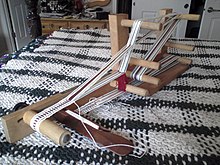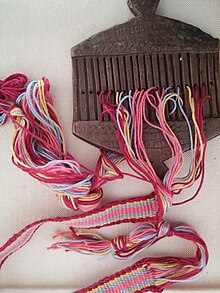| This article includes a list of general references, but it lacks sufficient corresponding inline citations. Please help to improve this article by introducing more precise citations. (April 2019) (Learn how and when to remove this message) |
Band weaving refers to the hand production of narrow woven fabric. This fabric may be called tape, band, inkle, strap, belt, back strap, trim, and more. It can be accomplished on a variety of types of looms, including inkle, band, tape, backstrap, and rigid heddle looms. Hole and slot heddles are also designed to weave bands. Depending on which loom is used, the material could be warp-faced or a balanced weave.
Types of band weaving


Inkle
Inkle weaving is a type of warp-faced weaving where the shed is created by manually raising or lowering the warp yarns, some of which are held in place by fixed heddles. According to the Oxford English Dictionary, the term inkle has several meanings, the first of which is "A kind of linen tape, formerly much used for various purposes." The derivation of the word is uncertain. Inkle weaving is commonly used for narrow work such as trims, straps and belts. Inkle weaving is done on a loom known as an inkle loom. One key element that differentiates inkle looms from other band looms is that a continuous warp is required.
History
A table-top inkle loom was patented by Mr. Gilmore of Stockton, CA in the 1930s but inkle looms and weaving predate this by centuries.
Inkle weaving was referred to 3 times in Shakespeare: in Love's Labour's Lost (Act III, Scene I), Pericles, Prince of Tyre (Act V), and in The Winter's Tale (Act IV, Scene IV). Jonathan Swift mentioned inkle weavers in his Polite Conversations.

Equipment
Inkle looms are constructed as floor-standing and table-top models. The loom is characterized by a wooden framework upon which dowels have been fastened. These dowels will hold the warp threads when the loom has been dressed.
One of the dowels, or a paddle, is constructed so that its position can be adjusted. This tensioning device will be taken in as weaving commences and the warp threads become shorter. Additional equipment includes yarn for the warp and weft, yarn or thread for forming heddles and a shuttle to hold the weft.
Process
The inkle loom is threaded with warp threads according to the weaver's design, alternating between yarn that can be raised and lowered and yarn that is secured in place through the use of the heddles. The raising and lowering of these warp threads creates the shed through which the weft thread will be carried on a shuttle. The weaver should make one pass with the shuttle with each opening of a shed through the raising and lowering of threads.


There are other more advanced techniques in which, instead of merely allowing warp threads to alternate in their up or down positions, individual threads are brought to the surface to form what is called a "pick up" pattern. One side of the band will show the exposed surfaces of warp threads while, on the other side of the pattern, the weft thread will be visible. Using a supplemental weft thread that will come up over the top of certain warp threads, brocaded designs can also be worked into the inkle band.
An inkle loom is also useful in the practice of tablet weaving for its added portability. The warp is threaded onto the loom as in inkle weaving, but weaving cards are used instead of alternating between free-hanging and heddle-secured yarn.
Tape
History
Handwoven tape was very important in Europe starting in the 1500s. This need for tape was also evident in the US, from the colonial period to the mid-1900s. It was used to tie and tie up clothing such as hosiery, tie pockets to garments, serve as candle wicks, ties for grain and feed bags, and other household uses. Many farm households had tape looms, which may well have been built by a family member.
Equipment
Because tape looms in their heyday were not mass produced, they took a wide variety of forms, most designed to be easily portable. There were types that were indicative of a certain geographic area. In Scandinavia, paddle-like hole and slot heddles were common, they were also found in colonial America. The earliest form of these rigid heddles is as a part of a backstrap set-up. This form of weaving has been used in Africa, South America, and Mexico. Box looms housing a rigid heddle were found in colonial America and in England in particular.
Band uses
Bands can be used as bookmarks, trim, belts, cords for jewelry, bag straps and more.Re-enactors use woven tape for garment ties and drawstrings, as well as other uses such as tying bundles. Inkle bands are quite strong and can be used in applications where a flat band is desired. Popular modern uses are guitar and camera straps, or, for particularly narrow bands, colorful shoelaces. Traditionally, inkle bands also served as belts and reins.

See also
- Loom
- Tablet weaving is often done on inkle looms
References
- ^ Weaver, Susan Faulker (2016). Handwoven tape : understanding and weaving early American and contemporary tape. Atglen, PA. ISBN 978-0-7643-5196-9. OCLC 946462509.
{{cite book}}: CS1 maint: location missing publisher (link) - ^ Bress, Helene (1990). Inkle weaving (Revised ed.). Rockville, Md.: Flower Valley Press. ISBN 0-9620543-1-3. OCLC 24358415.
- Atwater, Mary Meigs (1972). Byways in Handweaving: An Illustrated Guide to Rare Weaving Tcechniques (5th ed.). New York: MacMillan.
- "inkle, n.". OED Online. December 2022. Oxford University Press.
- Bradley, Lavinia (1982). Inkle weaving : a comprehensive manual. London: Routledge & K. Paul. ISBN 0-7100-9086-2. OCLC 8451174.
- "Inkle Weaving". www.degarmo.net. Retrieved 2023-01-13.
- ^ Tacker, Harold (1974). Band weaving; the techniques, looms, and uses for woven bands. Sylvia Tacker. New York: Van Nostrand Reinhold Co. ISBN 0-442-28404-7. OCLC 858209.
- Lancaster, Brianna. "Inkle-Woven Shoelaces". Weavezine.com. Syne Mitchell. Retrieved 21 May 2019.
Further reading
- Bress, Helene. Inkle Weaving. Flower Valley Press / Scribner, 1975, ISBN 0-9620543-1-3
- Brown, Rachel. The Weaving, Spinning, and Dyeing Book Second Edition Alfred A. Knopf, New York, 1983, ISBN 0-394-71595-0
- Dixon, Anne. The weaver's inkle pattern directory : 400 warp-faced weaves. Interweave Press, Loveland, CO, 2012. ISBN 9781596686472
- Folts, Teressa. The inkle path to weaving Serenity Weavers, 1977.
- Holland, Nina. Inkle loom weaving Watson-Guptill Publications, 1973. ISBN 0-8230-2551-9
- Holland, Nina. The Weaving Primer : A complete guide to Inkle, Backstrap, and Frame Looms Chilton Book Co., 1978. ISBN 0-8019-6625-6
- Tidball, Harriet. Weaving Inkle Bands Shuttle Craft Books Inc. 1969. ISBN 0-916658-27-9
- Sutton, Ann & Collingwood, Peter. The craft of the weaver Lark Books, 1983. ISBN 0-937274-10-0
External links
- Weaving on an Inkle Loom http://www.weavezine.com/content/weaving-inkle-loom
| Weaving | ||
|---|---|---|
| Weaves |  | |
| Components | ||
| Tools and techniques | ||
| Types of looms | ||
| Weavers |
| |
| Employment practices | ||
| Mills | ||